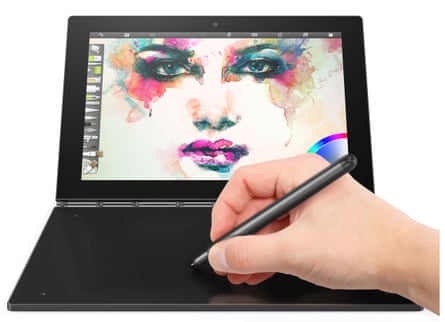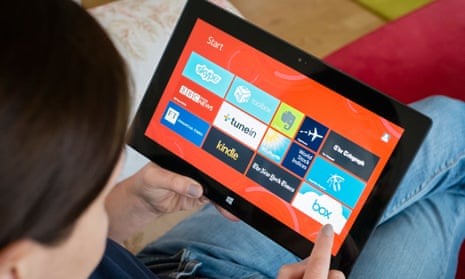My wife has used a Microsoft Surface RT tablet for a few years in her job as a tutor. She has found its size and the touch keyboard invaluable in her planning and writing up of lessons, especially as this often happens in the car between pupils. Unfortunately, it is becoming less reliable, and much slower, and she is looking for a replacement. She has looked at the new Surface Pros, but does not want to spend more than £500. She requires Microsoft Office, a long battery life and portability.
By the way, I also wanted to thank you for the advice you gave my daughter in What sort of tablet should I buy for drawing? Niamh bought a Wacom tablet and is very pleased. John
Microsoft launched the Surface RT in 2012 when the tablet market looked promising. It was the first tablet to run Windows on an ARM chip, which provided long battery life. It also made it incompatible with all the traditional software written for Intel x86 versions of Windows, including viruses.
The Guardian’s product and service reviews are independent and are in no way influenced by any advertiser or commercial initiative. We will earn a commission from the retailer if you buy something through an affiliate link. Learn more.
The Surface RT tablets included Microsoft Office, which was good, but it wasn’t optimised for touch-screen use, which was bad. Otherwise, users had to be content with Windows Store apps and web-based applications.
While Surface RT users loved their machines, there were not many of them, and Microsoft abandoned the ARM line in favour of the successful Intel-based Surface Pro versions. However, ARM-based versions will return to the market later this year.
Speeding up a PC
Your wife’s Surface RT should not have slowed down that much, and a reset might speed it up again. To do this, take a backup of the current system – or at least, all the personal data – and restore it to factory condition. Run the Settings app (cogwheel icon), select Update & security, click Recovery and then hit the “Get started” button under “Reset this PC”.
The drawback is that you will have to reinstall all the updates that have been downloaded previously. This could take some time.
You could also optimise Windows for speed.
Windows has a lot of visual effects: for example, things slide into view instead of instantly popping into view. To change this, type in “advanced system settings” to find the System Properties sheet from the old Control Panel. In the Performance section, click the Settings button and then select “Adjust for best performance”.
After that, go through the list of effects and restore any you still want. “Enable Peek”, “Show shadows under mouse pointer”, “Show window contents while dragging” and “Smooth edges of screen fonts” are worth keeping.
Unfortunately, the Surface RT is a sealed box, like most tablets. You can’t get the simple improvement that works with desktop and some laptop PCs: just add RAM.
Tablets and 2-in-1s
The whole tablet market is in decline – Apple iPad sales are roughly half what they were at their peak – and manufacturers are shifting resources to AR (augmented reality, such as the Microsoft HoloLens) and VR (virtual reality, such as the Oculus Rift). Windows PC manufacturers switched to 2-in-1s and then convertibles, where sales are still growing strongly.
Unfortunately, the better products are generally more expensive, including the Microsoft Surface Pro 4, the HP Spectre x2, HP Elite x2, and Dell Latitude 11 5175. There’s a huge gap between pro tablets and convertibles with Intel Core processors, 8GB of memory and proper SSDs and the cheap, casual models with Intel Atom processors, 2GB of memory and 32GB of eMMC Flash storage.
It can be hard to find affordable machines in the “sweet spot” between the two extremes. These may have Intel Core M processors such as the Core m3-6Y30 and 4GB or 8GB of memory. The best compromise is a Cherry Trail (x3, x5 or x7) Atom-powered machine with 64GB of eMMC storage.
The one I’d recommend at the moment is last year’s Lenovo Miix 310, which has an Atom x5-Z8350 processor, 4GB of memory and 64GB of storage for a current web price of £249.99 (£30 off). However, this week, Lenovo unveiled the Miix 320 with 128GB of storage, so it might be worth waiting for that.
The main alternative is the Asus Transformer Book T100HA, which has a Cherry Trail x5-Z8500 processor, 2GB of memory and either 32GB or 64GB of storage. Currently, eBuyer has the 2GB/64GB model for £229.97 with free delivery. The T100HA has been around for a while, and the Miix 310 has twice the memory and a better keyboard.
In both cases, the electronics are behind the screen, so you can detach the screen from the keyboard and use it as a tablet. (The virtual keyboard is built into Windows 10.) The alternative is to keep the electronics under the keyboard and fit a 360-degree hinge. Folding the keyboard behind the screen provides a somewhat thicker tablet. The Lenovo Yoga range pioneered this approach, and your wife could have a look at one to see if the idea is acceptable. Yogas come in dozens of configurations but a Yoga 300 with an Intel Pentium N3710, 4GB of memory and 64GB of storage costs £279.99 from PC World. The N3710 is faster than the x5-Z8500, though not by much.
Stylus required?

You don’t say if your wife is using a stylus. I hope so, because a Surface-style device, Microsoft OneNote and a stylus is a terrific system for educational use. However, adding a stylus and a pen-capable screen bumps up the price, usually beyond your budget.
The main exception is the Asus Transformer Mini T102HA (x5-Z8350/4GB/64GB) with a stylus, which costs £449.95 at John Lewis, or £398.46 on Amazon. However, Microsoft currently has a Signature Edition (ie crapware free) version for only £349.
I believe the Mini T102HA is the cheapest current 2-in-1 with a stylus, unless you are willing to risk a Chinese product such as a Teclast X3 Pro or X5 Pro. These aren’t even included in Tablet PC Review’s invaluable spreadsheet of pen-capable Windows 10 systems.
The other possibility is Microsoft’s Surface 3 – not the same as a Surface Pro 3 – if you can still find one at a reasonable price. Microsoft has some at a “student price” of £449.99, if you pre-qualify as a student.
Lenovo’s very innovative Yoga Book is also worth a look at £549.99.
ARM’s return
Windows 10 is a mobile operating system, like Android, and also runs on ARM chips in smartphones, which aren’t expected to run traditional x86 Windows programs. Later this year, however, we expect to see ARM-based tablets and small laptops running Windows 10 on the next-generation Qualcomm Snapdragon 835 processor. Qualcomm has a Microsoft demo video on its website.
These new devices won’t be the same as the Surface RT. The main difference is that they have enough power to run traditional x86 programs under emulation. The Snapdragon 835 also supports touch, pen and the latest wireless standards: LTE, 802.11ad and Bluetooth 5.
Early models will probably be designed and priced for corporate use, but consumer versions should follow.
Have you got another question for Jack? Email it to Ask.Jack@theguardian.com

Comments (…)
Sign in or create your Guardian account to join the discussion